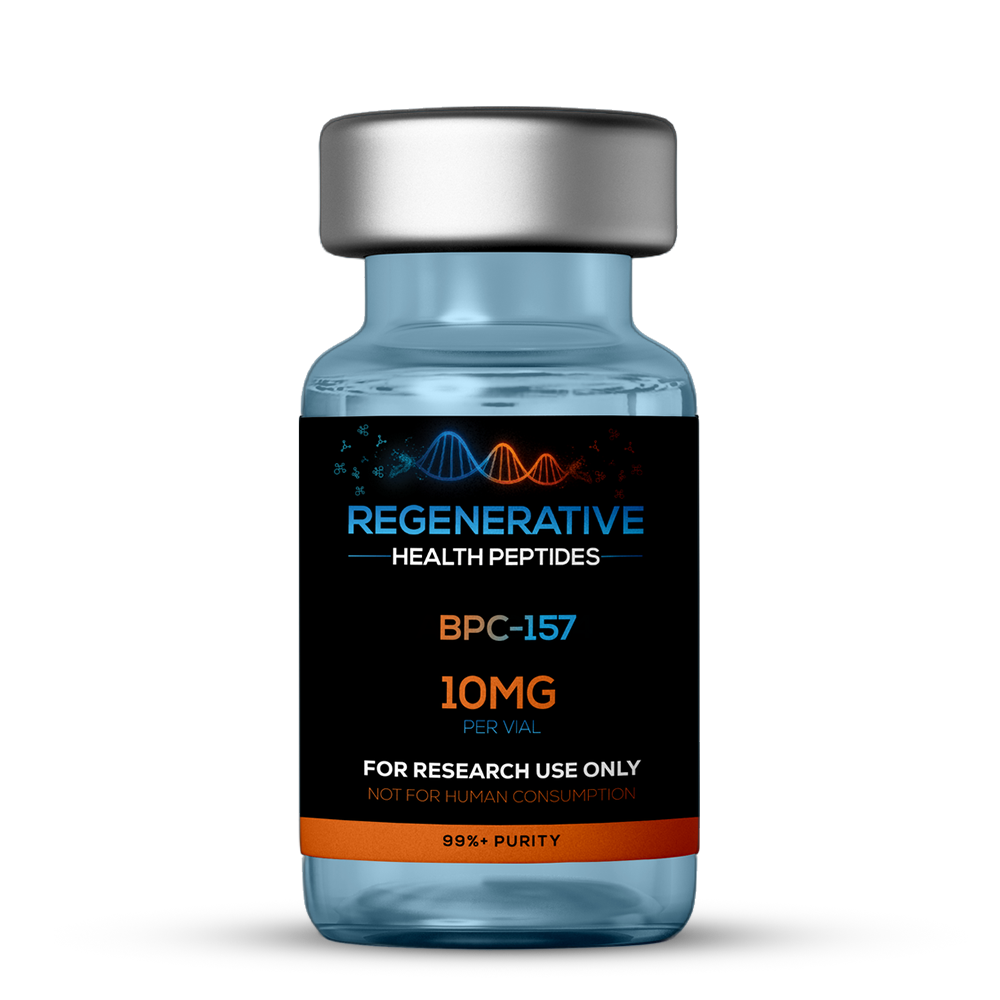BPC-157 (10mg)
$170.00
BPC-157 (Body Protection Compound 157) is a stable pentadecapeptide extensively studied for its regenerative and protective properties in tissue repair. Regenerative Health Peptides offers USA-made BPC-157 (10mg), ensuring high-quality standards for peptide research labs. Available exclusively for in-vitro studies, not for human or animal use.
Overview
BPC-157 is a synthetic pentadecapeptide comprising 15 amino acids, derived from a protective protein found naturally in gastric juice. Its structure allows stability against enzymatic degradation, positioning it as a preferred peptide for diverse regenerative research applications.
Peptide Structure
The specific sequence of BPC-157 is Gly-Glu-Pro-Pro-Pro-Gly-Lys-Pro-Ala-Asp-Asp-Ala-Gly-Leu-Val. This unique sequence is crucial for its enhanced resistance to enzymatic breakdown, making it suitable for sustained research.
Mechanisms of Action
Researchers extensively investigate BPC-157 for its cytoprotective, regenerative, and angiogenic properties. Its potential applications include gastrointestinal and musculoskeletal tissue repair, making it valuable for researchers specializing in regenerative therapies across the USA.
To Research
- Wound Healing
- Musculoskeletal Healing
- Gastrointestinal Protection
- Neuroprotective Potential
- Angiogenesis
Product Usage
This peptide is exclusively intended for “Research Use Only” and strictly prohibited for human or animal use. It is suitable only for in-vitro studies, which are conducted outside the body (Latin: in glass).
Disclaimer
All products and content provided on this website are exclusively for in-vitro research and educational purposes. They are not intended as drugs or medications and have not been approved by the FDA for any therapeutic use. Human or animal administration is strictly prohibited by law.
Wound Healing
BPC-157 accelerates tissue regeneration, enhancing angiogenesis, and promoting fibroblast proliferation, significantly speeding wound closure rates in preclinical studies.[1][2][4]
Musculoskeletal Healing
Studies demonstrate that BPC-157 supports tendon and ligament healing by enhancing cell proliferation and structural integrity in research models, underscoring its potential in musculoskeletal regenerative research.[5][6][8]
Gastrointestinal Protection
Its cytoprotective properties are notable in research targeting gastrointestinal lesions, ulcers, and inflammatory conditions, showing considerable promise in preclinical studies.[3][7][9]
Neuroprotective Potential
Preclinical data suggest BPC-157’s ability to offer neuroprotective benefits, aiding in neurological regenerative research through its regenerative properties.[10][11]
Angiogenesis
Research indicates BPC-157 effectively stimulates new blood vessel formation, a fundamental process essential to regenerative medicine and healing studies.[1][12]
References:
- Seiwerth et al. Journal of Physiology-Paris, 91, 173–178. (1997)
- Huang et al. Drug Design, Development and Therapy, 9, 2485-2499. (2015)
- Šola et al. FASEB Journal, 36. (2022)
- Seiwerth et al. Frontiers in Pharmacology. (2021)
- Chang et al. Journal of Applied Physiology, 110, 774–780. (2011)
- Chang et al. Molecules. (2014)
- Japjec et al. Biomedicines. (2021)
- Šebečić et al. Bone, 24, 195-202. (1999)
- Drmic et al. World Journal Gastroenterology, 24(48), 5462-5476. (2018)
- Hsieh et al. Journal of Molecular Medicine, 95(3), 323-333. (2017)
- Vukojević et al. Vascular Pharmacology, 106, 54-66. (2018)
- Duzel et al. World Journal Gastroenterology, 23(48), 8465-8488. (2017)
Store lyophilized BPC-157 peptides at -20°C. After reconstitution with bacteriostatic water, refrigerate at 4°C and utilize within 30 days. For long-term research storage exceeding one month, freezing at -80°C is recommended. Minimize freeze-thaw cycles to maintain peptide integrity.
